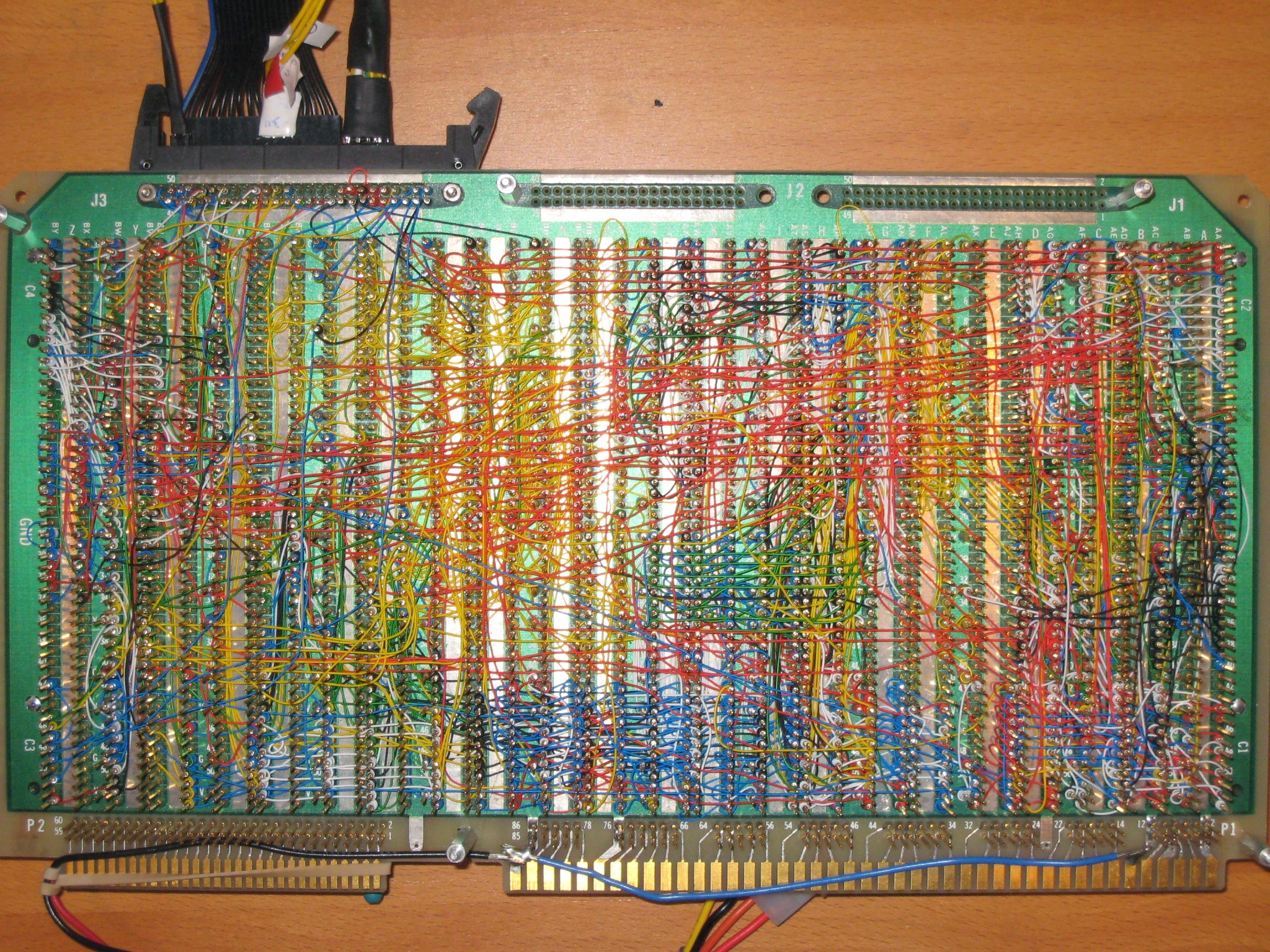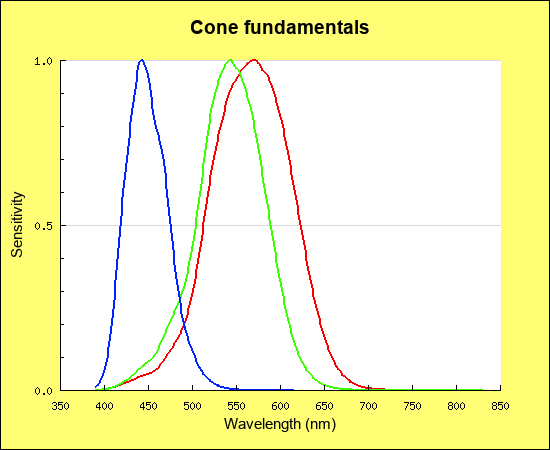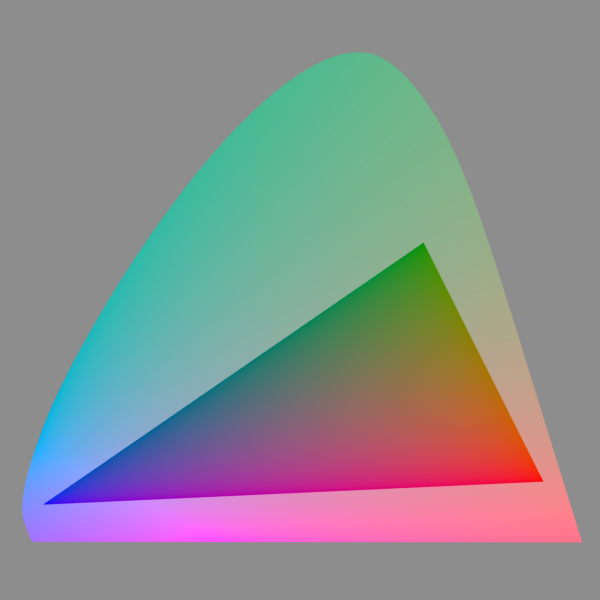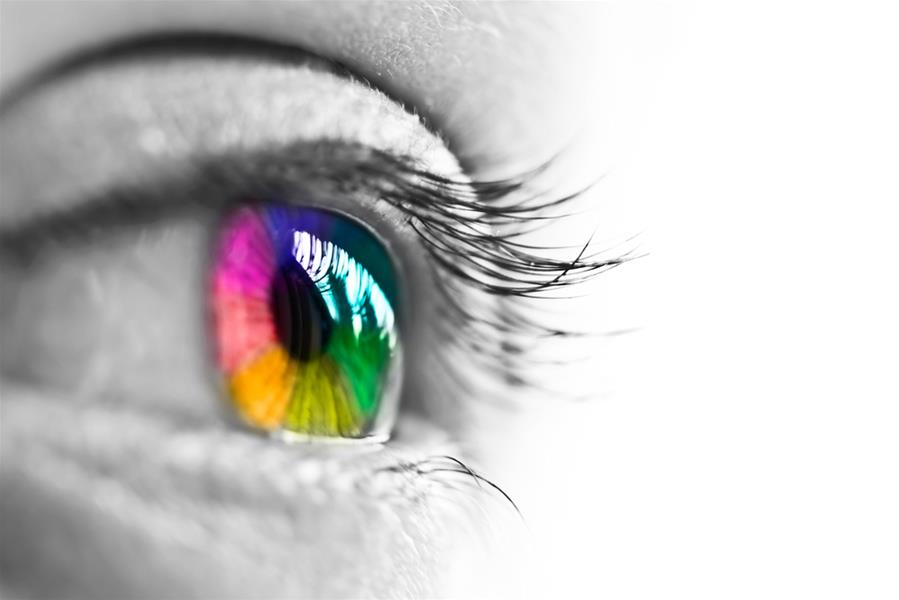Unreal claims concerning purple
-
@Zerosquare That's definitely more of a kluge, which is fitting, but not very reconfigurable.
-
Any hardware is reconfigurable when you have a soldering iron.
Or even if you don't:

-
I have been summoned, and so I appear.
-
@Zerosquare Wow, Multibus I; I haven't seen one of those in many years. (It took me a fair bit of research to even remember which bus it was that used those cards.) Fun fact: My first job out of high school, before I went off to uni, was working for a company that made (among many other things) prototyping boards for Multibus, back when it was the hot new(-ish) thing in the mid- to late-70s.
-
@HardwareGeek fun fact: the date you started that job is closer to WW2 than today.
-
-
@Gąska said in Unreal claims concerning purple:
Why it's so well documented that it's impossible for many people to hear the difference between /ʃ/ and /ɕ/, but there exists no analogous phenomenon in visual world?
Probably in part because detailed analysis and categorisation of colours happened much later than that of speech, so until 50 years ago or so, only the most visible differences (e.g. colour blindness) were noticed, the rest was simply put down to individual variability (there's always has been discussions as to "is this blue or green" and that was treated as mostly the same as personal preferences and taste) and not worthy of study.
This in turn might be linked to the complexity mentioned upthread about what is colour, whereas sound (at least sounds used in language) is slightly less complicated (I think?) and thus easier to study (for example, we have had devices to accurately record sounds (phonographs) for longer than the devices to record colour (cameras)). That means even if an individual notices differences in colour perception, it's harder to convey those differences to someone else ("hey, X does not see as 'green' the colour of this specific object that I cannot duplicate easily in large quantities" makes spreading information harder than "hey, X cannot pronounce the word 'foo' like we do" -- for colours we're left with comparing with natural objects (the colour of the sea, sky etc.) but since they naturally have large variations this isn't hugely useful).
Another reason might be that differences in sounds (may) affect basic communication so they are fairly obvious (for example when not differentiating sounds means confusing two words with very different meanings). They are also very noticeable (e.g. you can just hear someone speaking in a crowd and notice sounds they cannot pronounce), which makes them strong cultural identity markers. By comparison, differences in perceptions of colours are less likely to even be noticed (I'm struggling to imagine a situation where you say "pick up the green thingy" and I pick up the one you would have called "blue", not "green", since that implies two thingies of very similar colours and I'm not sure you would naturally use green/blue to refer to them if they are so similar plus the whole setup is starting to look like a lab experiment, not a real-life situation), and differences in perception of colours are harder to "passively" notice (unless I start saying "the sky is green", you can't know I'm perceiving colours differently from you and even then you have to process what I actually mean by it, whereas being unable to pronounce a sound is easier to notice and harder to fake (you can fake not being able to pronounce something, but not being able to!)).
What I'm saying is that, all in all and historically, the social aspects of pronunciation probably have more impact, and thus attracted more interest, that the social aspects of colour perception, which might answer your question.
-
@HardwareGeek said in Unreal claims concerning purple:
@Zerosquare said in Unreal claims concerning purple:
@dkf was FPGA-based
While @Tsaukpaetra uses somewhat simpler technology:

My preferred breadboard has sourdough rye on it…
-
@Zerosquare said in Unreal claims concerning purple:
Any hardware is reconfigurable when you have a soldering iron.
QFFT
-
@dkf said in Unreal claims concerning purple:
There are critical differences in pronunciation in some languages that I find intensely difficult to hear at all, and it's entirely due to how by brain discards the information.
You don’t even have to look to the very complex range of sounds represented by the letter <r> for examples of that. <d> and <t> both have pretty clear pronunciations /d/ resp. /t/, at least in Germanic languages. Yet a great many Dutch and (AFAIK) German speakers will have trouble with a <d> at the end of a word, saying and quite likely hearing it as /t/.
A friend of mine used to consistently type the name of the WoW zone Nagrand as “Nagrant” despite really only ever reading the name instead of saying it. I blamed it on devoicing the <d> to /t/ like good Dutch-speakers should.
-
@Zerosquare said in Unreal claims concerning purple:
Any hardware is reconfigurable when you have a soldering iron.
Or a hammer ...
-
@Gąska said in Unreal claims concerning purple:
Why it's so well documented that it's impossible for many people to hear the difference between /ʃ/ and /ɕ/, but there exists no analogous phenomenon in visual world?
So, something like:
(Wikipedia:)
The Himba people have been found to categorize colors differently from most Westerners and are able to easily distinguish close shades of green, barely discernible for most people.
Edit: @Gąska points out below that this likely is BS, so hey, there's that.
-
@Luhmann said in Unreal claims concerning purple:
@Zerosquare said in Unreal claims concerning purple:
Any hardware is reconfigurable when you have a soldering iron.
Or a hammer ...
It's the electronics equivalent of:

-
@Gąska said in Unreal claims concerning purple:
@HardwareGeek fun fact: the date you started that job is closer to WW2 than today.
So? Yesterday was closer to WW2 than today as well.
-
Guess it’s time for another round of clarifications, so buckle up everyone…
Colour has a few layers with fairly clear properties and applicability, but in casual contexts they all tend to get mixed up and make things seem far more confusing and less concrete than they really are.
Tier 1: physical
At this level, it’s all EMR. Colour does not exist as a meaningful concept here, and any discussion of the physical aspect as colour is bound to be misleading.
Here it’s about Spectral Power Distributions, which are relevant for all the ways real objects interact with light – emission, absorption, refraction, reflection, it all requires a full description of the relevant spectral intensity to some precision, like 1 nm or 5 nm.
The physical side of things is useless for describing human perception, and there’s way too much focus on it in most “explanations” of colour-related phenomena. When used appropriately, it’s 100% empirical and objective.
Tier 2: psychophysical
Originating from the structure of the human eye, this is where colours enter the picture. After being filtered through the lens, macular pigment, etc. etc. (processes still working at the physical level), incident light excites four photoreceptors. In photopic vision, only three are really relevant.

(2-deg LMS fundamentals based on the Stiles and Burch 10-deg CMFs adjusted to 2-deg)This projects the arbitrary complexity of an SPD onto a three-dimensional vector space. Seriously – psychophysical colours satisfy all the vector space axioms. The zero vector is black, scaling affects intensity, addition is standard additive blending. The real colours – those physically produceable in the real world (Emergency topicality alert! This includes purple.) – form a subset of this vector space, but mathematically it all holds together and certain illusions can indeed lead to actual perception of hypersaturated colours beyond the real ones.

Project the psychophysical colours onto two dimensions along the axis of intensity and you get something like this. Dark triangle is the sRGB gamut, rest of the horseshoe is a desaturated depiction of the real colours. Additive mixtures of any two colours lie along the line between them.In this analogy, primary colours are a basis. And there are infinitely many bases. Red, green and blue are often touted as magical, but any set of three linearly-independent colours is valid (just beware of practical concerns arising from the usual inability to “subtract” a colour). The choice of basis is arbitrary; “red”, “green” and “blue” don’t have a rigid definition.
Blah blah blah, maths, what’s the significance? This is the realm of colour spaces. Colour spaces indicate colours which are, to the standard observer, literally identical. If it stimulates the photoreceptors in the same manner, it’s the same colour. Appropriately-constructed colour spaces all have bijections between each other – linear sRGB (0.5, 0.5, 0.5) corresponds to CIE XYZ (0.475, 0.500, 0.544) corresponds to some excitation of LMS cone fundamentals I can’t be bothered to approximate. But they’re all the same.
So, the psychophysical level allows objective, empirical discussion of colour stimuli.
Tier 3: post-receptoral processing
Now things get less straightforward. The mechanisms here are harder to determine.
This is where cone opponency and chromatic adaptation happen and the upshot is, it’s how you can determine whether two differing stimuli are perceptibly unique, which Euclidean distance in a linear colour space can’t do too well.
Still empirical to get measurements and data, but constructing accurate models is not so trivial.
Tier 4: psychological interpretation
Abandon all hope here. This is the world of qualia where everything is subjective and nothing makes sense. Here you might discuss naming or the way a perception like “saturation” is generated. It can still be more concrete than psychology might otherwise imply, but that mostly depends on which aspects you discuss.
There’s a common tendency to interpret everything under the lens of psychology and pretend nothing’s objective or explainable, but most of us have very similar eyes things are more consistent than you might think.
Hope this helps… at the very least it’s something to copy-paste later.
The key points here are that colour stimuli are three-dimensional and unique, comparison of them is totally objective, but making relative judgements makes things harder.
-
@Gurth said in Unreal claims concerning purple:
good Dutch-speakers
 I don't understand how referring to the empty set supports your statement.
I don't understand how referring to the empty set supports your statement.
-
@dkf said in Unreal claims concerning purple:
(Yes, it is a circular definition. Brains are reconfigurable hardware; lots of things with them are self-reinforcing.)
That's actually a key component of consciousness. I recommend Hofstadter's I Am a Strange Loop. The book addresses the subject of qualia directly, as well.
-
@kazitor said in Unreal claims concerning purple:
At this level, it’s all EMR. Colour does not exist as a meaningful concept here, and any discussion of the physical aspect as colour is bound to be misleading.
So, when asking "Is this dildo purple?", since we're leaving out lighting conditions and the macular health of the observer, we must be talking about physics, yet also about color.
As technically correct as your explanation may be, all you're really saying (in the context of the title of this thread) is that the entire world is using the word "color" wrong.
The truth is that most people's usage of the word color, when used in the above sentence is equivalent to: "Would this dildo be described as purple by a typical person under typical lighting conditions?". And, of course, that gets us squarely into your Tier 4 where all answers are subjective.
-
-
@kazitor said in Unreal claims concerning purple:
@Shoreline
Assuming this is a serious question about why the rounded square is even there to begin with…Spectral colours are beyond the sRGB gamut. They cannot be encoded by the colour space of that image and could certainly never be properly displayed by your screen. I won’t get into the maths here, not that it’s particularly involved, but it is easily doable to represent the colour of spectral light shining against a grey background within the sRGB gamut.
Although I made the purple circle dominate far too much of it for the proper effect to appear, I think.
This is one the most accurate renderings of the visible spectrum you’ll find on the internet. Most others distort the colours, have huge uniform bands where they shouldn’t be, etc.
Then the rounded corners are just to be more artsy or something.
Somebody made an update and I clearly blanked on this reply from almost 6 months ago, of which I've understood maybe some of the words.
TBH my reply was just a shitpost implying I couldn't see purple based on the principle that it doesn't exist.
I think you're saying that the colour-spaces don't translate into each other well, one being a single dimension, and the other being entirely contained to a cube. I wouldn't want to get into the maths of that either, but then maybe it's simpler than I thought and something else is the complicated part.
I'm always up for some artsy rounded corners ofc.
Fun fact: HSB is two cones glued together with a grey-tasting center.
-
@dkf said in Unreal claims concerning purple:
@HardwareGeek said in Unreal claims concerning purple:
@Zerosquare said in Unreal claims concerning purple:
@dkf was FPGA-based
While @Tsaukpaetra uses somewhat simpler technology:

My preferred breadboard has sourdough rye on it…
Take a bit of that and yeast-ferment it to kvass, yo.
-
@kazitor said in Unreal claims concerning purple:
Now things get less straightforward. The mechanisms here are harder to determine.
There's significant complexity there, with the really annoying bit being the fact that neurons can suppress their neighbours. This increases the perceptual separation in some cases, but that is tricky to predict since the connections between neurons are random. (The brain adapts to all that randomness; the details are random but the overall effect is largely predictable.)
-
@dkf said in Unreal claims concerning purple:
@kazitor said in Unreal claims concerning purple:
Now things get less straightforward. The mechanisms here are harder to determine.
There's significant complexity there, with the really annoying bit being the fact that neurons can suppress their neighbours. This increases the perceptual separation in some cases, but that is tricky to predict since the connections between neurons are random. (The brain adapts to all that randomness; the details are random but the overall effect is largely predictable.)
There's a convenient and nearly valid schnitt available - the retinal electrochemistry vs everything else.
Ob. troll content - it is an overstatement to call the neuronal interconnect structure random.
-
@cvi said in Unreal claims concerning purple:
@Gąska said in Unreal claims concerning purple:
Why it's so well documented that it's impossible for many people to hear the difference between /ʃ/ and /ɕ/, but there exists no analogous phenomenon in visual world?
So, something like:
(Wikipedia:)
The Himba people have been found to categorize colors differently from most Westerners and are able to easily distinguish close shades of green, barely discernible for most people.
Yes. Thank you very much for that!
-
@cvi actually, no, that's not it. I mean, it would be what I'm looking for, if it wasn't completely made up.
I did the unthinkable and actually checked out what the cited paper says. And it says nothing about shades of green. The whole paper is about English and Himba children learning colors for the first time. The conclusion is that grouping colors is strongly (but not entirely) determined by culture, but they didn't actually test perception of colors.
So I did more googling to see whether there's maybe another study about Himba people's vision. I didn't find any. I did, however, found this blog post (hosted on University of Pennsylvania domain, so I find it credible):
It goes into detail about the history of that experiment and what exactly was tested and what the findings were. Bottom line:
The BBC's presentation of the mocked-up experiment — purporting to show that the Himba are completely unable to distinguish blue and green shades that seem quite different to us, but can easily distinguish shades of green that seem identical to us — was apparently a journalistic fabrication, created by the documentary's editors after the fact, and was never asserted by the researchers themselves, much less demonstrated experimentally.
-
-
@HardwareGeek said in Unreal claims concerning purple:
@Gąska said in Unreal claims concerning purple:
journalistic fabrication

Yes, kill all the journalists, then we'll find out what the truth is!
-
@Gąska Guess it pays off to actually track down the source.

There are a few other things that I also left open and still want to follow up. One thing that I've been wondering is if you can "train" color perception in any way. (For example, if you work with something where colors are important, do you actually get better at telling differences?) Problem is of course that actual color perception depends on so many different factors already (overall illumination matters a lot; and as the video you posted, color perception seems to be somewhat relative, i.e., depends on contrasts and background and so on).
-
This paper looks relevant (didn't read it yet because
 ):
):
-
@cvi said in Unreal claims concerning purple:
@Gąska Guess it pays off to actually track down the source.

There are a few other things that I also left open and still want to follow up. One thing that I've been wondering is if you can "train" color perception in any way. (For example, if you work with something where colors are important, do you actually get better at telling differences?) Problem is of course that actual color perception depends on so many different factors already (overall illumination matters a lot; and as the video you posted, color perception seems to be somewhat relative, i.e., depends on contrasts and background and so on).
Unless you can change some of the more FPGA stuff in the cerebellum, which is an option, sort of, the basic qualia are unlikely to change. I would however predict a measured increase in perception due to marked increase in descriptive ability.
-
@Zerosquare said in Unreal claims concerning purple:
This paper looks relevant (didn't read it yet because
 ):
):
The difficulty of separating raw perception from description is immense, and this study appears subject to that conflation.
@Tsaukpaetra , get the probes, if you would. The non-ferrous, please, as the MRI is likely to be wanted as well.
-
@Gribnit said in Unreal claims concerning purple:
@cvi said in Unreal claims concerning purple:
@Gąska Guess it pays off to actually track down the source.

There are a few other things that I also left open and still want to follow up. One thing that I've been wondering is if you can "train" color perception in any way. (For example, if you work with something where colors are important, do you actually get better at telling differences?) Problem is of course that actual color perception depends on so many different factors already (overall illumination matters a lot; and as the video you posted, color perception seems to be somewhat relative, i.e., depends on contrasts and background and so on).
Unless you can change some of the more FPGA stuff in the cerebellum, which is an option, sort of, the basic qualia are unlikely to change. I would however predict a measured increase in perception due to marked increase in descriptive ability.
Except we know that's not really true. New things can be learnt throughout your whole life (except if you suffer from certain neurodegenerative diseases) and that means new qualia, new patterns of neural firing. The reason basic qualia are so stable, so rarely lost, is that they are reinforced frequently, either by direct daily experience or by dreaming. Thinking about a thing makes it easier to remember (even if the recall isn't accurate, due to conflation of similar memories.)
If it was just the cerebellum that was able to change in adulthood, we wouldn't learn except for very specialised things; the cerebellum is what does muscle control and low-level action planning. (Yes, the size and complexity of the cerebellum indicates that this is a very difficult task.) Other types of memories are elsewhere, probably close to the part of the brain that needs them most.
-
@dkf said in Unreal claims concerning purple:
@Gribnit said in Unreal claims concerning purple:
@cvi said in Unreal claims concerning purple:
@Gąska Guess it pays off to actually track down the source.

There are a few other things that I also left open and still want to follow up. One thing that I've been wondering is if you can "train" color perception in any way. (For example, if you work with something where colors are important, do you actually get better at telling differences?) Problem is of course that actual color perception depends on so many different factors already (overall illumination matters a lot; and as the video you posted, color perception seems to be somewhat relative, i.e., depends on contrasts and background and so on).
Unless you can change some of the more FPGA stuff in the cerebellum, which is an option, sort of, the basic qualia are unlikely to change. I would however predict a measured increase in perception due to marked increase in descriptive ability.
Except we know that's not really true. New things can be learnt throughout your whole life (except if you suffer from certain neurodegenerative diseases) and that means new qualia, new patterns of neural firing. The reason basic qualia are so stable, so rarely lost, is that they are reinforced frequently, either by direct daily experience or by dreaming. Thinking about a thing makes it easier to remember (even if the recall isn't accurate, due to conflation of similar memories.)
If it was just the cerebellum that was able to change in adulthood, we wouldn't learn except for very specialised things; the cerebellum is what does muscle control and low-level action planning. (Yes, the size and complexity of the cerebellum indicates that this is a very difficult task.) Other types of memories are elsewhere, probably close to the part of the brain that needs them most.
I'd propose that the cerebellum is among the more hard-wired portions than less - the FPGA point of reference was to distinguish vs more generalization. It's also involved in visual processing, for the focus feedback and other loops.
Unlikely doesn't by any means mean unachievable. But, difficulty of distinguishing between fluency and faculty, calls for the probes.
-
@dkf: are you really discussing brain biology with Gribnit?

-
@Zerosquare said in Unreal claims concerning purple:
@dkf: are you really discussing brain biology with Gribnit?

Don't worry, I was never really here.
-
@Zerosquare I don't know about discussing, but certainly an interesting research subject. How does a quasi-human survive without a functioning cortex?
-
@HardwareGeek said in Unreal claims concerning purple:
@Zerosquare I don't know about discussing, but certainly an interesting research subject. How does a quasi-human survive without a functioning cortex?
Symbiotic microbial complex.
-
@cvi said in Unreal claims concerning purple:
One thing that I've been wondering is if you can "train" color perception in any way. (For example, if you work with something where colors are important, do you actually get better at telling differences?)
Given that you can definitely train other senses in a similar way (i.e. musicians are trained in sound recognition, perfume-makers (so called "noses") are trained in odour recognition...), I would be very surprised if you could not also train colour perception.
-
@remi said in Unreal claims concerning purple:
Given that you can definitely train other senses in a similar way (i.e. musicians are trained in sound recognition, perfume-makers (so called "noses") are trained in odour recognition...), I would be very surprised if you could not also train colour perception.
Note that it's not seeing more colours, but rather distinguishing more colours.
-
@dkf something something
fuchiafushschyafuck-ya, pink.
-
@remi said in Unreal claims concerning purple:
@dkf something something
fuchiafushschyafuck-ya, pink. : "pinkish". In fuchia's case, purplish is also acceptable.
: "pinkish". In fuchia's case, purplish is also acceptable.
-
@remi Fuchsia. Color named after the flower, and the flower is named after somebody named Fuchs, I guess; at least it's spelled as if it is, and that's how I remember the spelling.
-
@HardwareGeek said in Unreal claims concerning purple:
Fuchsia. Color named after the flower, and the flower is named after somebody named Fuchs, I guess
And if English wasn't occasionally so po-faced, we'd be talking about “no fuchsia given”…
-
@HardwareGeek said in Unreal claims concerning purple:
Fuchsia
Why would somebody name a color after Google's wannabe OS?

-
@dkf said in Unreal claims concerning purple:
@remi said in Unreal claims concerning purple:
Given that you can definitely train other senses in a similar way (i.e. musicians are trained in sound recognition, perfume-makers (so called "noses") are trained in odour recognition...), I would be very surprised if you could not also train colour perception.
Note that it's not seeing more colours, but rather distinguishing more colours.
Also seeing more colors, the vast majority of retinal hyperchromats are women.
-
@remi said in Unreal claims concerning purple:
@dkf something something
fuchiafushschyafuck-ya, pinktransparent
-
-
@Zerosquare paywalled

-
The complete text is there, just hidden. All you have to do is enable reader mode (F9 for Firefox) or disable the style sheets.
-
 s
s Vintage TDWTF meme.
Vintage TDWTF meme.
 Different shades of perception
Different shades of perception



